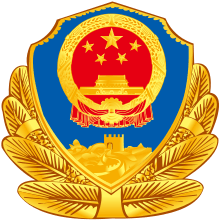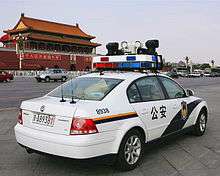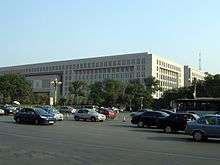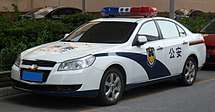Ministry of Public Security (China)
The Ministry of Public Security of the People's Republic of China (MPS) is the principal police and security authority of the People's Republic of China and the government ministry that exercises oversight over and is ultimately responsible for day-to-day law enforcement. It has 1.9 million officers. It is headed by the Minister of Public Security. Prior to 1954, it was known as the Ministry of Public Security of the Central People's Government. The Ministry operates the system of Public Security Bureaus, which are broadly the equivalent of police forces or police stations in other countries. The candidate for the minister of the MPS is nominated by the Premier of the People's Republic of China and approved by the National People's Congress. As the main domestic security agency in the People's Republic of China, the MPS is the equivalent of the National Police Agency in Japan or national police in other countries.
| 中华人民共和国公安部 Zhōnghuá Rénmín Gònghéguó Gōng'ānbù | |
.svg.png) Emblem of the People's Republic of China (in the centre of each ministry's seal) | |
 Emblem of the People's Police of the PRC (with branches outside the Public Security organs) | |
| Agency overview | |
|---|---|
| Formed | 1954 |
| Preceding agency |
|
| Type | Constituent Department of the State Council (cabinet-level) |
| Jurisdiction | |
| Headquarters | Beijing |
| Employees | 1.9 million police officers |
| Ministers responsible |
|
| Parent agency | State Council |
| Child agencies |
|
| Website | www |
When it was established in 1949 (after the Communist victory in the Chinese Civil War), the MPS, with PLA General Luo Ruiqing as its first Minister, was, based on Soviet and Eastern Bloc models, responsible for all aspects of security, ranging from regular police work to intelligence, counter-intelligence and suppression of anti-communist political and social groups.[1] Military intelligence remained with the PLA General Staff, while the International Liaison Department of the Communist Party of China was active in fomenting revolution internationally by funneling weapons, money and resources to various pro-Chinese groups worldwide.[2]
However, since the creation, in 1983, of the Ministry of State Security (MSS), which took over responsibility for many national security issues such as domestic and foreign intelligence-gathering and fighting espionage and subversion, the MPS has focused its efforts on regular law enforcement. Hong Kong and Macau have their own security bureaus or agencies and police forces. As of November 2017, the Minister of Public Security is Zhao Kezhi.
History
The Ministry of Public Security was among the very first government organs of the PRC. It superseded the Ministry of Public Security of the Chinese Communist Party's Central Military Commission, a transitional body created in July 1949 by removing the security service remit from the CCP Central Department of Social Affairs (CDSA). The ministry began operations on 1 November 1949, at the end of a two-week-long National Conference of Senior Public Security Cadres. Most of its initial staff of less than 500 cadres came from the (former) regional CCP North China Department of Social Affairs. At the national level, its creation signaled the formal abolition of the CDSA. The ministry moved to its present location, in the heart of the one-time foreign legation quarters in Beijing, in the spring of 1950.[3]
List of Ministers
| No. | Name | From | To | Premier |
|---|---|---|---|---|
| 1 | Luo Ruiqing | October 1949 | September 1959 | Zhou Enlai |
| 2 | Xie Fuzhi | September 1959 | March 1972 | Zhou Enlai |
| 3 | Li Zhen | March 1972 | 1973 | Zhou Enlai |
| 4 | Hua Guofeng | 1973 | March 1977 | Zhou Enlai Hua Guofeng |
| 5 | Zhao Cangbi | March 1977 | April 1983 | Hua Guofeng Zhao Ziyang |
| 6 | Liu Fuzhi | May 1983 | August 1985 | Zhao Ziyang |
| 7 | Ruan Chongwu | September 1985 | March 1987 | Zhao Ziyang |
| 8 | Wang Fang | April 1987 | November 1990 | Zhao Ziyang Li Peng |
| 9 | Tao Siju | December 1990 | March 1998 | Li Peng |
| 10 | Jia Chunwang | March 1998 | December 2002 | Li Peng Zhu Rongji |
| 11 | Zhou Yongkang | December 2002 | October 2007 | Zhu Rongji Wen Jiabao |
| 12 | Meng Jianzhu | October 2007 | December 2012 | Wen Jiabao |
| 13 | Guo Shengkun | December 2012 | November 2017 | Wen Jiabao Li Keqiang |
| 14 | Zhao Kezhi | November 2017 | Incumbent | Li Keqiang |
Organization


The MPS is organized into functional departments (see below). Subordinate to the MPS are the provincial- and municipal-level PSB and sub-bureaus at the county and urban district levels. At the grassroots level, finally, there are police stations (paichusuo) which serve as the direct point of contact between police and ordinary citizens. While public security considerations have weighed heavily at all levels of administration since the founding of the PRC, the police are perceived by some outside observers to wield progressively greater influence at lower levels of government.
The organization of local public security stations may be inferred from the tasks with which the police are charged. Generally, each police station has sections assigned to cover census and household registration matters, pretrial investigations, welfare, traffic control, and other activities. Each also has a detention center.
Departmental structure
At the time of its creation, the Ministry of Public Security had a simple departmental structure comprising one general office and six functional directorates, numbered sequentially and responsible for political security, economic security, public order and administration, border security, armed security, and personnel. Today's ministry is organized into the following departments:
- Central Office,
- Supervision,
- Personnel & Training,
- Public Relations,
- Economic Crime Investigation,
- Public Order Administration,
- Border Control,
- Criminal Investigation,
- Exit & Entry Administration,
- Fire Control,
- Security Protection,
- Public Information Network Security Supervision,
- Penitentiary Administration,
- Traffic Control,
- Legal Affairs,
- International Cooperation,
- Equipment and Finance,
- Drug Control,
- Science & Technology,
- Counter-terrorism, and
- Info-communications.
Railway, navigation, civil aviation, forestry and anti-smuggling public security departments are under the dual leadership of their superior administration and the MPS.[4]
Responsibilities and operations
In the 1980s the public security station—the police element in closest contact with the people—was supervised by the public security subbureau as well as by local governments and procuratorates. The procuratorate could assume direct responsibility for any case that it chose, and it supervised investigations in those cases in which the public security station was allowed to conduct investigations. A great deal of coordination occurred among the public security organs, the procuratorates, and the courts, so that a trial was unlikely to produce a surprise outcome.
The public security station generally had considerably broader responsibilities than a police station in the West, involving itself in every aspect of the district people's lives. In a rural area a station typically has a chief, a deputy chief, a small administrative staff, and a small police force. In an urban area it usually has a greater number of administrative staff members and seven to eighteen patrolmen. Its criminal law activities included investigation, apprehension, interrogation, and temporary detention. The station's household section maintained a registry of all persons living in the area. Births, deaths, marriages, and divorces were recorded and confirmed through random household checks. The station regulated all hotels and required visitors who remained beyond a certain number of days to register. All theaters, cinemas, radio equipment, and printing presses also were registered with the local public security station, permitting it to regulate gatherings and censor information effectively. It also regulated the possession, transportation, and use of all explosives, guns, ammunition, and poisons.
Another important police function was controlling change of residence. Without such controls, large numbers of rural residents undoubtedly would move to the overcrowded cities in search of better living standards, work, or education. In April 1984 the State Council issued the Tentative Regulations Governing People's Republic of China Resident Identity, this became the identification card of the People's Republic of China. The regulations, implemented over a period of years, required all residents over sixteen years of age, except active-duty members of the People's Liberation Army and the People's Armed Police and inmates serving prison sentences, to be issued resident identity cards by the MPS. The identification card indicates the name, sex, nationality, ethnicity, date of birth, and address of the bearer. Cards for persons sixteen to twenty-five years of age were valid for ten years; those for persons between twenty-five and forty-five were valid for twenty years; and persons over forty-five were issued permanent cards. As of early 1987, only 70 million people had been issued identity cards, well below the national goal. Also, even those with resident identity cards preferred to use other forms of identification.
Criminal procedure powers
Public security officials also made extensive use of their authority to impose administrative sanctions through two sets of documents. These were the 1957 Regulations on re-education through labor, which were reissued in 1979 with amendments (abolished 2015), and the 1957 Regulations Governing Offenses Against Public Order, which were rescinded and replaced in 1986 by regulations of the same name. Offenders under the Regulations on Reeducation Through Labor might include "vagabonds, people who have no proper occupation, and people who repeatedly breach public order." The police could apprehend such individuals and sentence them to reeducation through labor with the approval of local labor-training administration committees. The 1957 regulations placed no limit on the length of sentences, but beginning in the early 1960s sentences of three or four years were the norm. The 1979 amended Regulations, however, limited the length of reeducation through labor to three years with the possibility of extensions in extraordinary cases. The Regulations Governing Offenses Against Public Order empowered the police to admonish, fine, or detain people for up to fifteen days. Goods illegally in the possession of an offender were to be confiscated, and payment was imposed for damages or hospital fees in the event that injury had been caused.
The criminal laws in force after January 1, 1980, restricted police powers regarding arrests, investigations, and searches. A public security official or a citizen could apprehend a suspect under emergency conditions, but a court or procuratorate was required to approve the arrest. The accused had to be questioned within twenty-four hours and his or her family or work unit notified of the detention "except in circumstances where notification would hinder the investigation or there was no way to notify them." Any premeditated arrest required a warrant from a court or procuratorate. The time that an accused could be held pending investigation was limited to three to seven days, and incarceration without due process was made illegal.
Two officials were needed to conduct a criminal investigation. They were required to show identification and, apparently, to inform the accused of the crime allegedly committed before he or she was questioned. The suspect could refuse to answer only those questions irrelevant to the case. Torture was rendered illegal.
The 1980 laws also provided that in conjunction with an arrest the police could conduct an emergency search; otherwise, a warrant was required. They had the right to search the person, property, and residence of an accused and the person of any injured party. They could intercept mail belonging to the accused and order an autopsy whenever cause of death was unclear.
In July 1980 the government approved new regulations governing police use of weapons and force. Police personnel could use their batons only in self-defense or when necessary to subdue or prevent the escape of violent criminals or rioters. Lethal weapons, such as pistols, could be used if necessary to stop violent riots, to lessen the overall loss of life, or to subdue surrounded but still resisting criminals. The regulations even governed use of sirens, police lights, and whistles.
Public relations
External
The relationship between the police officers assigned to neighborhood patrols and the people was close. Police officers lived in a neighborhood on a long-term assignment and were expected to know all the residents on a personal basis. Their task was not only to prevent and punish crime but to promote desirable behavior by counseling and acting as role models. These socially responsible aspects of the police officer's duties were constant responsibilities, and the bond between the public security units and the people was strengthened annually by means of "cherish-the-people" months, during which the police officer made a special effort to help the local people, especially the aged and infirm.
Internal
The Public Security Construction (公安建设) was a classified serial publication for internal purposes.[5] During the disastrous Great Leap Forward between 1958–1961, the Public Security Work Bulletin (公安工作简报) was a top-secret serial which often described China's serious food shortages, directly contradicting Mao Zedong's promises of "bountiful economic fruit".[6][7] Another periodical People’s Public Security (人民公安)[lower-alpha 1] was also produced and classified as "for official use only".[8][9]
Recruitment
Police are officially drawn from every segment of the population without restriction as to sex or ethnic origin. Selection is based on political loyalty, intelligence, and health, as it is for the PLA. There is at least one police school in every provincial-level unit, and others are operated by municipalities. Usually those police designated for leadership positions attend the police schools, and patrolmen are trained at the unit and on the job. Legal training is emphasized as a method of improving the quality of the police forces. In 1985 three institutions of higher learning for police personnel were established—the Chinese People's Public Security University, the University of Police Officers, and the Institute of Criminal Police—offering more than twenty special courses. Students are recruited from the pool of senior middle-school graduates under twenty-two years of age, with a waiver to twenty-five years of age for those who have a minimum of two years' experience in public security work.
Firearms
Local municipal police under the MPS formally were usually unarmed with firearms routinely in contrast to the soldiers of the People's Armed Police (PAP), however they are armed with expandable batons and incapacitant sprays. Sometimes, multiple use tactical knives are issued to the policemen.
A decision has been taken to train in the use of sidearms to all frontline MPS personnel since 2006. The 9×19mm double-action revolver manufactured by the China North Industries Corporation [10] are issued to frontline personnel, and officers armed them routinely
For more firepower, detectives and special units are routinely armed with NP 22 and QSZ-92 semi-automatic pistols. Sub-machine guns, rifles and light machine guns are deployed when more firepower are required.
- Handguns
| Make/Model | Type | Origin | Usage since | Main users |
| Norinco | Type 54 | 1954–1988 | Frontline officers (obsolete, mostly phased out by QSZ-92) | |
| Norinco | Type 64 | 1980–2008 | Detectives & frontline officers(obsolete, mostly phased out by QSW-06) | |
| Norinco | 9mm Revolver | 2006–Present | Patrol police | |
| Norinco | Type 77 | 1981–Present | Detectives | |
| Norinco | QSZ-92 | 1996–Present | Frontline officers | |
| Norinco | QSW-06 | 2006–Present | Special forces | |
| Norinco | NP 22 | 2015–Present | Special forces & detectives | |
| Taurus | PT109 | 2014–Present | Limited use in guard details |
- Submachine guns
| Make/Model | Type | Origin | Usage since | Main users |
| Norinco | Type 79 [11] | 1979–Present | Special units | |
| Norinco | NR-08 | 2008–Present | Special units | |
| Norinco | JS 9 mm | 2006–Present | Special units |
- Rifles
| Make/Model | Type | Origin | Usage since | Main users |
| Norinco | QBZ-95 | 1997–Present | Special units | |
| Norinco | QBZ-03 | 2002–Present | Special units | |
| Norinco | Type 81 | 1983–Present | Reserve units | |
| Norinco | Norinco CQ | 1980–Present | Some police units, notably Sichuan Police Department and Chongqing SWAT |
- Shotguns
| Make/Model | Type | Origin | Usage since | Main users |
| Norinco | Norinco HP9-1 | 2001–Present | Patrol Units |
Fleet

- BYD e6
- BMW 5 series sedans
- Chevrolet sedans (China manufactured)
- Ford sedans (China manufactured)
- Humvee SUVs
- Mercedes sedans
- SAIC MG sedans
- SAIC Roewe 750
- Toyota sedans (China manufactured)
- Volkswagen Jetta sedans
- Volkswagen Passat sedans
- Volkswagen Santana sedans
- River Patrol craft
See also
- Public Security Construction
- Public Security Work Bulletin
- People's Public Security
- National identity cards in the Republic of China (Taiwan)
- National Police Agency of the Republic of China (Taiwan)
Notes
- Its official English-language title is People's Police.
References
Citations
- From the Social Affairs Department to Ministry of Public Security, in Xuezhi Guo: China's Security State: Philosophy, Evolution, and Politics, 2012, Cambridge University Press
- Directorate of Intelligence, Central Intelligence Agency (December 1971). "Intelligence Report: The International Liaison Department of the Chinese Communist Party" (PDF). Archived from the original (PDF) on May 31, 2012. Retrieved June 17, 2019.
- Wang Zhongfang, "Gonganbu shi zemyang chenglide," in Zhu Chunlin (ed.) Lishi shunjian (Beijing: Qunzhong chubanshe, 1999), Vol. 1, pp. 3–16.
- "Archived copy". Archived from the original on December 8, 2012. Retrieved September 12, 2011.CS1 maint: archived copy as title (link)
- Schoenhals, Michael (February 18, 2013). Spying for the People: Mao's Secret Agents, 1949–1967. Cambridge University Press. pp. 105–6. ISBN 9781139619714.
- Cheek, Timothy (August 23, 2010). A Critical Introduction to Mao. Cambridge University Press. p. 116. ISBN 9781139789042.
- Schoenhals, Michael (February 18, 2013). Spying for the People: Mao's Secret Agents, 1949–1967. Cambridge University Press. pp. 31, 42, 106. ISBN 9781139619714.
- Schoenhals, Michael (February 18, 2013). Spying for the People: Mao's Secret Agents, 1949–1967. Cambridge University Press. p. 129. ISBN 9781139619714.
- Lim, J.; Petrone, K. (December 14, 2010). Gender Politics and Mass Dictatorship: Global Perspectives. Springer. p. 238. ISBN 9780230283275.
- "9mm Chinese Police revolver". Archived from the original on April 6, 2008. Retrieved March 6, 2008.
Sources
- John Pike, Federation of American Scientists, Intelligence Resource Program, Ministry of Public Security
- Kam C. Wong, Chinese Policing: History and Reform (N.Y.: Peter Lang, 2009)
- Kam C. Wong, Police Reform in China: A Chinese Perspective (Taylor and Francis, 2011) (July 2011)
- Angelo Paratico, The Karma Killers IUniverse, 2009
.jpg)
_01.jpg)